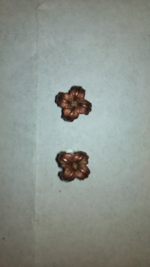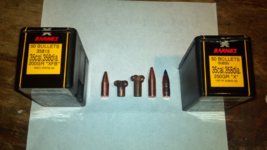4. Presumption of "Kinetic Energy Deposit" to Be a Mechanism of Wounding:
Serious misunderstanding has been generated by looking upon "kinetic energy transfer" from projectile to tissue as a mechanism of injury. In spite of data to the contrary (1, 63), many assume that the amount of "kinetic energy deposit" in the body by a projectile is a measure of damage (2-5, 36, 37, 40). Such opinions ignore the direct interaction of projectile and tissue that is the crux of wound ballistics. Wounds that result in a given amount of "kinetic energy deposit" may differ widely. The nondeforming rifle bullet of the AK-74 (
Fig 6) causes a large temporary cavity which can cause marked disruption in some tissue (liver), but has far less effect in others (muscle, lung, bowel wall) (9). A similar temporary cavity such as that produced by the M-16 (
Fig 2), stretching tissue that has been riddled by bullet fragments, causes a much larger permanent cavity by detaching tissue segments between the fragment paths. Thus projectile fragmentation can turn the energy used in temporary cavitation into a truly destructive force because it is focused on areas weakened by fragment paths rather than being absorbed evenly by the tissue mass. The synergy between projectile fragmentation and cavitation can greatly increase the damage done by a given amount of kinetic energy.
A large slow projectile (
Fig 7) will crush (permanent cavity) a large amount of tissue, whereas a small fast missile with the same kinetic energy (
Fig 4) will stretch more tissue (temporary cavity) but crush little. If the tissue crushed by a projectile includes the wall of the aorta, far more damaging consequences are likely to result than if this same projectile "deposits" the same amount of energy beside this vessel.
Many body tissues (muscle, skin, bowel wall, lung) are soft and flexible--the physical characteristics of a good shock absorber. Drop a raw egg onto a cement floor from a height of 2 m; then drop a rubber ball of the same mass from the same height. The kinetic energy exchange in both dropped objects was the same at the moment of impact. Compare the difference in effect; the egg breaks while the ball rebounds undamaged. Most living animal soft tissue has a consistency much closer to that of the rubber ball than to that of the brittle egg shell. This simple experiment demonstrates the fallacy in the common assumption that all kinetic energy "deposited" in the body does damage.
The assumption that "kinetic energy deposit" is directly proportional to damage done to tissues also fails to recognize the components of the projectile-tissue collision that use energy but do not cause tissue disruption. They are 1) sonic pressure wave, 2) heating of the tissue, 3) heating of the projectile, 4) deformation of the projectile, and 5) motion imparted to the tissue (gelatin bloc displacement for example).
The popular format for determination of "kinetic energy deposit" uses a chronograph to determine striking velocity and another to determine exit velocity. A 15-cm thick block of tissue simulant (gelatin or soap) is the target most often used. This method has one big factor in its favor; it is simple and easy to do. As for its validity, the interested reader is referred to wound profiles shown in Figs 1-7. Comparing only the first 15 cm of the missile path with the entire missile path as shown on the profiles shows the severe limitation of the 15-cm block format. The assumption by weapons developers that only the first 15 cm of the penetrating projectile's path through tissue is of clinical significance (64) may simplify their job, but fails to provide sufficient information for valid prediction of the projectile's wounding potential. The length of bullet trajectories through the human torso can be up to four times as long as those in these small blocs. Even if this method were scientifically valid, its use has been further flawed by nearly all investigators who have included the M-16 rifle bullet in those projectiles tested. This method assumes that the projectile's mass remains constant through both chronographs. The M-16 routinely loses one third of its mass in the form of fragments which may remain in the target (see
Fig 2). The part of the bullet that passes through the second chronograph screens weighs only about two-thirds as much as the intact bullet that passed through the first set of screens. No provision is made for catching and weighing the projectile to correct for bullet fragmentation when it occurs. The failure to correct for loss of bullet mass can cause large errors in "energy deposit" data (8).
Surgeons sometimes excise tissue from experimental missile wounds that is, in their judgment, nonviable and compare the weight of tissue excised with the "kinetic energy deposited" (65). A surgeon's judgment and his technique of tissue excision is very subjective, as shown by Berlin et al (66), who found in a comparison that "One surgeon excised less tissue at low energy transfers and rather more at high energy transfers than the other surgeon, although both surgeons used the same criteria when judging the tissues." None of these experiments included control animals to verify that tissue the surgeon had declared "nonviable" actually became necrotic if left in place. Interestingly, all studies in which animals were kept alive for objective observations of wound healing report less lasting tissue damage than estimated from observation of the wound in the first few hours after it was inflicted (43-47, 67, 68). In a study of over 4,000 wounded in WW II it was remarked, "It is surprising to see how much apparently nonvital tissue recovered" (69).
Anyone yet unconvinced of the fallacy in using kinetic energy alone to measure wounding capacity might wish to consider the example of a modern broadhead hunting arrow. It is used to kill all species of big game, yet its striking energy is only about 50 ft-lb (68 Joules)-- less than that of the .22 Short bullet. Energy is used efficiently by the sharp blade of the broadhead arrow. Cutting tissue is far more efficient than crushing it, and crushing it is far more efficient than tearing it apart by stretch (as in temporary cavitation).





